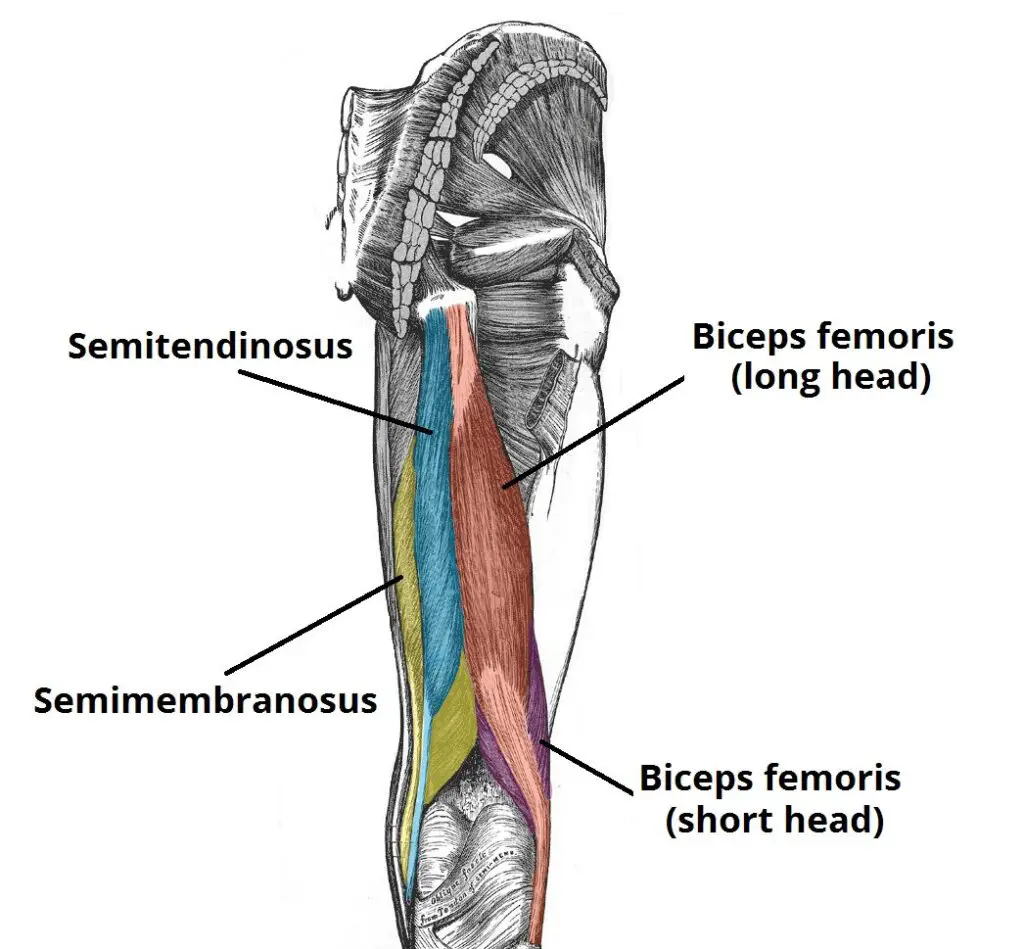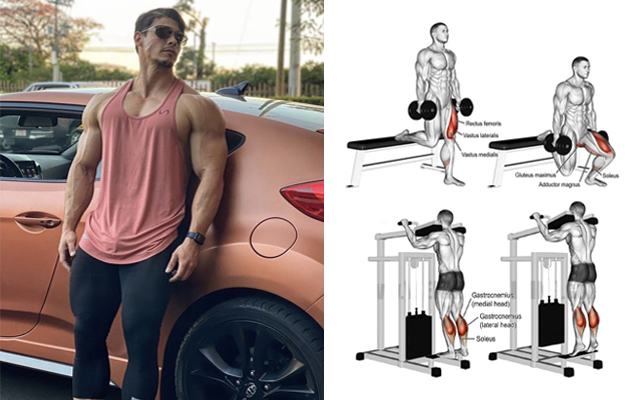In the world of fitness, certain muscle groups often steal the spotlight. The biceps, abs, and glutes are usually the stars of the show, while others, like the hamstrings, are often overlooked. But what happens when these unsung heroes are neglected in our workout routines? The hamstrings, located at the back of our thighs, play a crucial role in many daily activities and athletic movements. Yet, they are frequently undertrained, leading to a host of potential issues. In this article, we delve into the importance of hamstring workouts, the risks associated with neglecting them, and the impact it can have on our overall health and fitness. So, let’s pull back the curtain and give the hamstrings the attention they deserve.
Anatomy and Function of Hamstrings

The hamstrings are a group of three muscles located at the back of the thigh. They play a crucial role in many movements, including walking, running, and jumping. Here’s a detailed look at their anatomy and function:
Anatomy
- Biceps Femoris: This muscle has two parts, a long head and a short head. The long head originates from the ischial tuberosity in the pelvis, while the short head originates from the femur. Both heads are inserted into the head of the fibula.
- Semitendinosus: This muscle also originates from the ischial tuberosity and inserts into the medial aspect of the upper tibial shaft.
- Semimembranosus: Similar to the semitendinosus, it originates from the ischial tuberosity and inserts into the medial tibia.
Function
- Knee Flexion: All three muscles work together to flex the knee joint.
- Hip Extension: They also assist in extending the hip when the body moves from a bent position to an upright position.
- Leg Rotation: The hamstrings are involved in rotating the leg; the biceps femoris helps in external rotation, while the semitendinosus and semimembranosus contribute to internal rotation.
The hamstrings are essential for stability and movement, and their strength and flexibility are crucial for athletic performance and daily activities. Neglecting these muscles can lead to various issues, including injuries and imbalances. It’s important to include hamstring exercises in your fitness routine to maintain their health and function.
Consequences of Neglecting Hamstring Exercises
Neglecting hamstring exercises can lead to several negative consequences for both general health and athletic performance. Here are some key points to consider:
- Muscle Imbalance: Without regular exercise, the hamstrings can become weaker than the surrounding muscles, leading to an imbalance that may affect movement and stability.
- Reduced Flexibility: Lack of exercise can result in tight hamstrings, which may decrease flexibility and range of motion, making daily activities and sports more difficult.
- Increased Injury Risk: Weak and tight hamstrings are more susceptible to strains and tears, especially during activities that involve sudden starts, stops, or changes in direction.
- Posture Problems: Tight hamstrings can pull the pelvis into a posterior tilt, leading to poor posture and potentially causing lower back pain.
- Decreased Athletic Performance: Hamstrings play a crucial role in explosive movements, such as sprinting and jumping. Neglecting them can lead to a decline in overall athletic ability.
- Chronic Pain and Discomfort: Over time, tightness and weakness in the hamstrings can lead to chronic pain, which can be debilitating and limit physical activity.
- Rehabilitation Challenges: If an injury does occur, recovery may be more difficult and prolonged due to pre-existing conditions of tightness and weakness.
It’s important to include regular hamstring strengthening and stretching exercises in a workout routine to prevent these issues and maintain overall leg health and function.
Tightness and Stiffness
Tightness and stiffness in the hamstrings can have several effects on your body’s function and overall well-being. Here are some key points to include:
- Limited Mobility: Tight hamstrings can significantly reduce the range of motion in the legs, affecting basic movements like walking or bending over.
- Posture Issues: They can cause a posterior pelvic tilt, leading to a flattened lower back and potentially resulting in poor posture and back pain.
- Increased Injury Risk: Stiff hamstrings are more prone to strains and tears, especially during activities that require quick changes in speed or direction.
- Pain and Discomfort: Chronic tightness can lead to discomfort and pain, which may become more pronounced after periods of inactivity, such as sitting for long hours or after waking up.
- Compensation by Other Muscles: When hamstrings are tight, other muscles may overcompensate, leading to muscle imbalances and further increasing the risk of injury.
- Impact on Athletic Performance: For athletes, tight hamstrings can hinder performance by limiting explosive movements and agility.
- Connection to Lower Back Pain: Tight hamstrings can increase the pressure on the lower back, which is a common cause of lower back pain.
- Difficulty in Performing Stretches and Exercises: Tightness can make it challenging to perform certain stretches and exercises, which can impede progress in fitness routines.
Ways to alleviate tightness and stiffness;
- Regular Stretching: Engage in daily stretching exercises specifically targeting the hamstrings. This can include lying, seated, or standing stretches.
- Foam Rolling: Use a foam roller to massage and loosen the hamstring muscles. It can help increase blood flow and reduce muscle tension.
- Warm-Up and Cool-Down: Always warm up before exercising to prepare the muscles for activity, and cool down afterwards to help maintain flexibility.
- Yoga: Yoga stretches can be particularly beneficial for improving flexibility and reducing muscle tightness.
- Active Lifestyle: Incorporate movement throughout the day, especially if you have a sedentary job. Walking, swimming, or engaging in light activities can help prevent stiffness.
- Posture Awareness: Be mindful of maintaining good posture, both when sitting and standing, to prevent the hamstrings from shortening and becoming tight.
- Strengthening Exercises: Strengthen the hamstrings with exercises like leg curls and deadlifts to improve muscle balance and reduce the risk of tightness.
- Professional Massage: Consider scheduling appointments with a licensed massage therapist for deep tissue massages to help release muscle tightness.
By regularly practicing these methods, you can help maintain hamstring flexibility, reduce the risk of injury, and improve overall leg health.
Impact on Posture and Movement
Neglecting hamstring exercises can have a significant impact on both posture and movement. Here’s how:
- Posture: Tight hamstrings can cause the pelvis to tilt backward, flattening the lower back and leading to a hunched posture. This can contribute to lower back pain and affect the natural alignment of the spine.
- Movement: The hamstrings are involved in many movements, including walking, running, and bending. If they are tight, these movements can become restricted, leading to decreased mobility and an increased risk of injury.
- Balance: Hamstring flexibility is important for maintaining balance. Tight hamstrings can disrupt your center of gravity, making it harder to perform activities that require stability, such as standing on one leg or navigating uneven surfaces.
- Lower Back Health: The strain from tight hamstrings can increase pressure on the lower back, potentially leading to chronic pain and conditions like sciatica, where pain radiates down the leg.
- Knee Function: Since the hamstrings cross the knee joint, tightness can affect how the knee moves and functions, possibly leading to knee pain and other joint issues.
To mitigate these issues, it’s important to maintain hamstring flexibility through regular stretching and strengthening exercises. This will help ensure proper posture, reduce the risk of injury, and maintain a healthy range of motion in daily activities.
Injury Risks
Neglecting hamstring exercises can increase the risk of several types of injuries. Here are some injury risks associated with not exercising the hamstrings:
- Strains and Tears: The hamstrings are susceptible to strains and tears, especially during activities that involve sudden movements or heavy lifting.
- Muscle Weakness: Weak hamstrings can’t handle the stress of exercise as well, making them more likely to be injured.
- Muscle Imbalance: When the hamstrings are weaker than the muscles at the front of the thigh (quadriceps), it can lead to muscle imbalances and increase the risk of injuries.
- Reduced Flexibility: Tight hamstrings can lead to a decreased range of motion, which can increase the risk of injury during physical activities.
- Chronic Pain: Tight or weak hamstrings can contribute to chronic pain syndromes, especially in the lower back and knees.
- Re-Injury: Returning to strenuous exercise too quickly after a hamstring injury can lead to re-injury. It’s important to allow adequate time for healing and to engage in proper rehabilitation exercises.
Comparing Front and Back Squats
To minimize these risks, it’s essential to maintain hamstring strength and flexibility through regular exercise and stretching. This will help ensure the health and resilience of the hamstring muscles, reducing the likelihood of injury.
Rehabilitation and Recovery
Rehabilitation and recovery from hamstring injuries involve several stages to ensure proper healing and to prevent future injuries. Here’s a structured approach to discuss:
Initial Treatment (Acute Phase)
- Rest: Avoid activities that cause pain, swelling, or discomfort.
- Ice: Apply ice packs to the injured area for 15-20 minutes every two hours.
- Compression: Use an elastic compression bandage around the thigh to prevent additional swelling.
- Elevation: Keep the leg elevated above heart level to reduce swelling.
Pain Management
- Isometric Exercises: Engage in gentle isometric exercises, like bridge holds, to maintain muscle activation without causing further injury.
- Pain Relief: Over-the-counter pain relievers can help reduce pain and inflammation during the initial recovery phase.
Rehabilitation Exercises
- Stretching: Once the acute pain subsides, start with gentle stretching exercises to improve flexibility.
- Strengthening: Gradually introduce strengthening exercises, focusing on both the hamstrings and the surrounding muscles to ensure balance.
Advanced Rehabilitation
- Functional Training: Incorporate exercises that mimic daily activities or sports-specific movements to prepare the muscles for return to full activity.
- Progressive Loading: Slowly increase the intensity and load of exercises to build strength and resilience in the hamstrings.
Recovery and Prevention
- Gradual Return to Activity: Return to normal activities or sports gradually, and avoid pushing too hard too quickly.
- Ongoing Maintenance: Continue with regular stretching and strengthening exercises even after recovery to prevent re-injury.
Functional Training for Muscle Building
It’s important to tailor the rehabilitation process to the individual’s specific needs and the severity of the injury. Consulting with a healthcare professional or a physical therapist can provide guidance and ensure that the recovery plan is appropriate.
Preventive Measures
Preventing hamstring injuries involves a combination of proper warm-up, conditioning, and awareness of body mechanics. Here are some preventive measures to consider:
- Warm-Up Properly: Engage in a dynamic warm-up routine before activities to prepare the muscles for exercise.
- Gradual Progression: Increase the intensity and duration of exercises gradually to avoid overloading the muscles.
- Strength Training: Incorporate exercises that strengthen the hamstrings, glutes, and core to support the lower back and improve stability.
- Flexibility Exercises: Regular stretching can improve flexibility and reduce the risk of muscle tightness and injury.
- Proper Technique: Ensure that all exercises and movements are performed with the correct technique to avoid unnecessary strain on the hamstrings.
- Adequate Recovery: Allow sufficient time for recovery between intense workouts to prevent overuse injuries.
- Balanced Training: Include a variety of exercises in your routine to ensure balanced muscle development and prevent imbalances.
- Listen to Your Body: Pay attention to signs of fatigue and discomfort, which may indicate the need for rest or a change in your exercise regimen.
Best Squat Techniques for Quads
By following these measures, you can help reduce the risk of hamstring injuries and maintain healthy, functional muscles. Remember, it’s always a good idea to consult with a fitness professional or physical therapist to tailor a prevention plan to your specific needs and activities.
Benefits of Strong Hamstrings

Having strong hamstrings offers numerous benefits for both athletic performance and everyday activities. Here are some key advantages:
- Balanced Leg Strength: Strong hamstrings contribute to overall leg strength, which can enhance athletic performance and daily activities. They help balance the strength between the front and back of the thigh, preventing muscle imbalances.
- Injury Prevention: Well-developed hamstrings stabilize the knee joint, reducing the risk of knee injuries. They also help prevent strains and other injuries during physically demanding activities.
- Improved Athletic Performance: Strong hamstrings are crucial for activities like running, jumping, and lifting objects from the ground. They assist in extending the hip joint and decelerating the body, which is critical for sports performance.
- Enhanced Daily Function: These muscles are involved in daily mobility tasks such as standing up straight and walking. Strong hamstrings make it easier to perform everyday movements like bending down to pick up items or getting up from a seated position.
- Better Posture: Strong hamstrings support a proper posture by maintaining the natural curvature of the lower back and aligning the pelvis and legs.
- Decreased Risk of Sciatica: Hamstring strength can decrease the risk of sciatica, a condition where pain radiates along the sciatic nerve, often due to a herniated disc or spinal stenosis.
- Flexibility: While strength training can sometimes be associated with decreased flexibility, strong hamstrings that are also regularly stretched can improve overall leg flexibility.
Goblet Squat and Hamstring Activation
Incorporating hamstring strengthening exercises into your fitness routine can provide these benefits and contribute to a healthier, more active lifestyle. Remember to balance strength training with flexibility exercises for the best results.
FAQs
Q 1. How can I tell if my hamstrings are too tight?
Ans. A ‘normal’ hamstring length allows a person to lie on their back and, with the knee straight, flex the hip 90 degrees. Tightness is indicated if you cannot achieve this without consistent stretching.
Q 2. Can hamstring strength affect my running form?
Ans. Yes, weak hamstrings can lead to an overreliance on the quadriceps for stability and power, which can adversely affect running form and lead to muscle imbalances.
Q 3. What’s the best overall exercise to build hamstrings?
Ans. The stiff leg deadlift and its variations are highly effective. However, the best exercise may vary depending on individual needs and fitness levels.
Q 4. Do regular squats work hamstrings?
Ans. Regular squats do engage the hamstrings, but not as much as exercises specifically targeting the posterior chain, like deadlifts or good mornings.
Q 5. Should I train my hamstrings every day?
Ans. It’s not recommended to train the same muscle group every day. Hamstrings need time to recover and grow stronger between workouts.
Q 6. What workout machines target hamstrings?
Ans. Machines like the leg curl machine and the seated or lying leg press can target the hamstrings effectively.
Q 7. Are high reps or low reps better for hamstring development?
Ans. Both can be effective. High reps with lighter weights can build endurance, while low reps with heavier weights can increase strength. It’s best to incorporate a mix of both into your routine.
Q 8. How long until I notice hamstring growth?
Ans. This varies by individual, but with consistent training, you might start to see changes in as little as 4-6 weeks.
Q 9. Why is it important to balance hamstring and quad exercises?
Ans. Balancing these exercises helps prevent muscle imbalances, reduces the risk of injury, and ensures even development for better stability and strength.
Conclusion
In conclusion, the hamstrings play a vital role in both athletic performance and everyday activities. Neglecting these muscles can lead to a host of issues, including muscle imbalances, reduced flexibility, increased injury risk, and negative impacts on posture and movement. Conversely, maintaining strong and flexible hamstrings through regular exercise can enhance athletic abilities, prevent injuries, and improve overall quality of life.
The hamstrings deserve attention in any fitness regimen, not only for the benefits they bring but also to avoid the complications that arise from neglecting them. By understanding the importance of hamstring health and taking proactive steps to care for these muscles, individuals can enjoy a more active, pain-free lifestyle. Remember, a balanced approach to exercise that includes both strengthening and stretching is key to keeping your hamstrings—and your body—in top condition.

Good day, and welcome to Fitthour. My name is Shubham Vijay, and I am a certified personal trainer and nutrition coach with 6 years of experience in the fitness industry. At Fitthour, we specialize in types of training, such as strength training, cardio, or HIIT, and our mission is to help clients achieve their fitness goals and improve their overall health.



